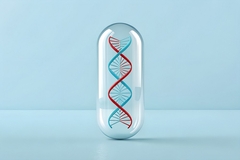Sodas Sweetened with HFCS Deliver Unexpected Jolt of Unhealthy Fructose

Contrary to prevailing assumptions, the findings show that the HFCS (a mixture of glucose and fructose produced from corn) in popular sodas may be as high as 65 percent fructose, nearly 20 percent higher than commonly assumed.
Oct 28 2010 --- While soda reigns as the single largest contributor to America's rapidly expanding waistlines, research released shows that the high fructose corn syrup (HFCS) used to sweeten America's most popular beverages is delivering a megadose of fructose (a sweeter and more harmful form of sugar), far higher than previously thought.
Researchers at the Childhood Obesity Research Center at the University of Southern California's Keck School of Medicine analyzed the sugar profiles of 23 popular sodas and discovered surprising information about the amount of fructose in the drinks. Contrary to prevailing assumptions, the findings show that the HFCS (a mixture of glucose and fructose produced from corn) in popular sodas may be as high as 65 percent fructose, nearly 20 percent higher than commonly assumed.
"The elevated fructose levels in the sodas most Americans drink are of particular concern because of the negative effects fructose has on the body," explained study author Dr. Michael Goran. "Unlike glucose (the smaller component of HFCS), over consumption of fructose is directly responsible for a broad spectrum of negative health effects."
The weight gain caused by sugary sodas can dramatically increase the risk for type 2 diabetes and cardiovascular disease. But, as Goran points out, because the body processes fructose differently than glucose, consuming large amounts of fructose greatly exacerbates the risk for those diseases by also causing fatty liver disease, insulin resistance, increased triglyceride levels and an acute rise in blood pressure.
The average American drinks over 50 gallons of soda a year, ingesting about 34 pounds of sugar. Over the past 30 years, the jump in consumption of soda accounts for 43 percent of the per capita increase in daily caloric intake, making it the prime driver behind the obesity epidemic.
"Given the huge amount of soda Americans consume, it's important that we have a more exact understanding of what we're drinking, including specific label information on the types of sugars. The lack of information -- or perhaps even misinformation -- we have had about the fructose levels in HFCS-sweetened beverages means that soda drinkers may be gambling with their health even more than we have previously thought," said Dr. Harold Goldstein of the California Center for Public Health Advocacy.
The study also raises questions about the accuracy of nutrition label reporting by manufacturers. When testing the Mexican Coca-Cola that lists "sugar" on the ingredient list, for instance, the researchers did not detect any sucrose (traditional sugar) but rather found near equal amounts of fructose and glucose, results which suggest the use of HFCS.












